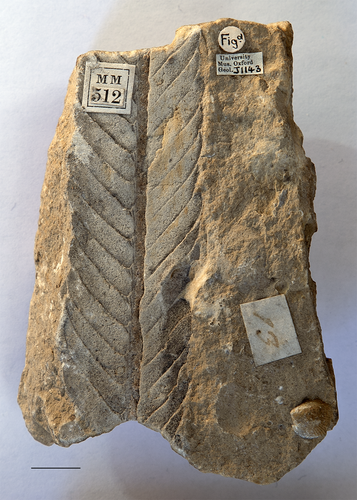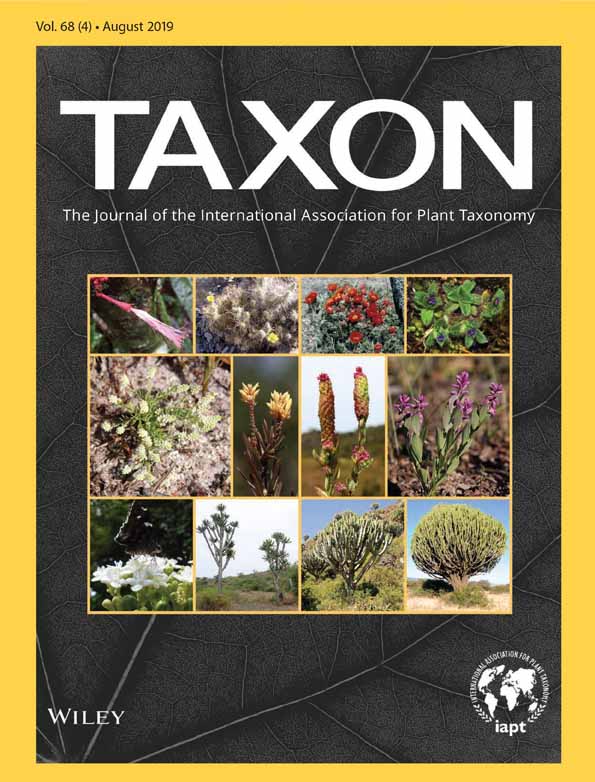(2710) Proposal to conserve the name Otozamites (fossil Cycadophyta: Bennettitales) against Otopteris
(2710) Otozamites Braun in Münster, Beitr. Petref.-Kunde 6: 36. 1843, nom. cons. prop.
Typus: O. bucklandii (Brongn.) Brongn. in Orbigny, Dict. Univ. Hist. Nat. 13: 110. 30 Jun–7 Jul 1849 (Filicites bucklandii Brongn. in Ann. Sci. Nat. (Paris) 4: 422. Apr 1825).
(=) Otopteris Lindl. & Hutton, Foss. Fl. Gr. Brit. 2: 142. Oct 1834.
Typus (vide Andrews in Bull. U.S. Geol. Surv. 1013: 199. 1955): O. obtusa Lindl. & Hutton
The sixth part of Münster's Beiträge zur Petrefacten-Kunde starts with a chapter, written by Braun (in Münster, Beitr. Petref.-Kunde 6: 1–46. 1843), mainly on fossil plants found in the region of Bayreuth in Bavaria (S Germany). In section II of this chapter, Braun described a few new genera and new species. On p. 21, he started a discussion and description of a beautiful new species of Zamites, for which he presented the name Zamites brevifolius Braun, with its name and a diagnosis on p. 23.
On p. 34 he started section IV, on fossil representatives of Zamia s.l. (along with some new species of Ctenis). In this section, on p. 36, he presented three new genera for these fossil zamias: Otozamites, Podozamites, and Pterozamites. In Otozamites he definitely included Zamites bucklandii and six other species of Zamites. Braun's presentation is remarkable, because the idea has long existed that Otopteris and Otozamites represent the same genus, i.e., are taxonomic synonyms – but Braun did not put Otopteris in the synonymy of Otozamites. We now submit a proposal to conserve Otozamites against Otopteris, because it is Otozamites that has long been in use. A.T. Brongniart (in Orbigny, Dict. Univ. Hist. Nat. 13: 110. 30 Jun–7 Jul 1849) already united the two genera, retaining the name Otozamites because he treated it as a cycad (“famille des Cycadées”) not as a fern. Later in the 19th century there were still some discussions on the issue of whether it was a fern (in which case one continued with Otopteris), or a cycadophyte (in which case one adopted Otozamites). Before the end of that century, it appeared that everybody agreed: a cycadophyte, and thus everybody used the name Otozamites, and Otopteris was forgotten.
The conservation of Otozamites against Otopteris has been proposed previously, more than 50 years ago, in two papers by the same author: Karl Kilpper (in Regnum Veg. 40: 30–31. 1965, in Taxon 17: 548–552. 1968). Both proposals were rejected (Mamay in Taxon 18: 481. 1969), but not for good nomenclatural or taxonomic reasons, and with a recommendation for further study.
Kilpper's proposals included various errors. In the first (l.c. 1965) he stated that Braun had overlooked the genus of Lindley & Hutton, i.e., Otopteris, but this is not the case. Kilpper apparently looked only at the first genus (Otozamites) on page 36 of Braun's account, and had not noticed that on the same page, Otopteris was cited as a synonym of a constituent of Braun's third genus, i.e., Pterozamites subg. Taeniopteroides. Kilpper continued (p. 30–31, in German, translated by us) with “The diagnoses of both genera are almost the same. Both are unequivocally synonyms of each other. The name Otozamites Fr. Braun thus is illegitimate, […] thus should be protected against Otopteris by conservation.” Otozamites is not, however, illegitimate under current rules, as Braun did not include the type of any name that ought to have been adopted (Art. 52.1 & 52.2 of the ICN – Turland & al. in Regnum Veg. 159. 2018). Braun did cite “Odontopteris. Sternb.”, i.e., Odontopteris (Brongn.) Sternb. (Vers. Fl. Vorwelt 1(4, Tent.): xxi. 1825), as a synonym of Otozamites, but as this is a later homonym of Odontopteris Bernh. (in J. Bot. (Schrader) 1800(2): 127. 1801), applicable to non-fossil pteridophytes, it was not available for Braun to adopt. [Odontopteris (Brongn.) Sternb. has since been conserved against its earlier homonym.]
In his second proposal Kilpper (l.c. 1968) provided an elaborate discussion on Otozamites, albeit with the same errors: that Braun had overlooked Otopteris Lindl. & Hutton and that Otozamites was illegitimate. In his first proposal, Kilpper (l.c. 1965: 31) had noted that Brongniart (l.c. 1849) had designated O. bucklandii as type of Otozamites but in the later paper suggested that this had still to be settled. In Kilpper's proposals, there is nothing about a choice of the type of Otopteris – probably because he considered that Otozamites should be conserved against it.
We agree that Brongniart's choice of O. bucklandii, explicitly confirmed by Saporta (Paléont. Franç., Pl. Jurass. 2: 44–45. Apr 1876), is an appropriate one. When Brongniart made this choice, he referred to an illustration by H.T. De la Beche (in Trans. Geol. Soc. London, ser. 2. 1: t. 7, fig. 2. 1822). This is of a specimen that was collected by Buckland and which is still in the Oxford University Museum of Natural History (OUMNH). We were able to obtain from Oxford a very good picture of this specimen, of which the “ears”, typical for the genus Otozamites, are better visible than on that 1822 illustration – see Fig. 1. It clearly concerns the same specimen! As noted by De la Beche (l.c.: 45–46) and confirmed in the Buckland collection in Oxford, the specimen was collected at Axminster (Devon) close to the south coast of England, in Jurassic (Liassic) sediments. When Brongniart (l.c. 1825) described Filicites bucklandii, he referred to specimens/material from two localities in England (“Lime” [Lyme Regis] and Axminster) that he considered as “var. α. Brittanica”, referring De la Beche's figure to that variety, and from two localities in France that he considered as “var. β. Gallica” and that he, himself, figured (Brongniart, l.c. 1825: t. 19, fig. 3). Brongniart's own figure was quite clear, but very small (only four pinnules). So we can well understand that for the type of the generic name, he again (l.c. 1849) referred to the “bien figuré” of De la Beche. We have now decided to designate here the specimen OUMNH J.1143 (also labelled with number “MM 512”), from Axminster as the lectotype of Filicites bucklandii. This material has been included within Otopteris graphica Bean ex Leckenby (in Quart. J. Geol. Soc. London 20: 78. 1864), making that name a synonym of Otozamites bucklandii, whereas the material upon which F. bucklandii var. gallica is based has never has been identified with any later collections.

The type specimen of O. obtusa was figured by Lindley & Hutton (Foss. Fl. Gr. Brit. 2: 128. 1834) and Seward (in Foss. Pl. 3: 538. 1917), and is deposited in the Oxford University Museum of Natural History (OUMNH J.1141).
Some important species of Otozamites are: O. bengalensis (Oldham & Morris) Schimp. (Traité Paléontol. Vég. 2: 172. 1870), O. brevifolius Braun (in Münster, Beitr. Petref.-Kunde 6: 23, 29. 1843), O. bunburyanus Zigno (Fl. Foss. Oolith. 2: 102. 1881), O. goeppertianus (Dunker) Seward (Foss. Pl. 3: 544. 1917), O. gracilis (Kurr) Miq. (Prodr. Syst. Cycad.: 32. 1861), O. leckenbyi T.M. Harris (Yorkshire Jurass. Fl. 3: 23. 1969), O. marginatus (Saporta) Saporta (Paléont. Franç., Pl. Jurass. 2: 168. 1873), O. parviauriculata C.A. Menéndez (in Bull. Brit. Mus. (Nat. Hist.), Geol. 12: 4. 1966), O. penna T.M. Harris (in Ann. Mag. Nat. Hist., ser. 11, 12: 484. 1946), O. schenkii (Heer) Seward (in Mém. Soc. Géol. Belgique 5: 242. 1925), O. thomasii T.M. Harris (l.c. 1969: 21), O. venosus T.M. Harris (in Ann. Mag. Nat. Hist., ser. 12, 2: 571. 1950).
About 100 species of Otozamites exist; without conservation, the vast majority of their names would have to be transferred to Otopteris, one of the few exceptions being Otozamites marginatus that is based on Otopteris marginatus. Since 1875, no further species have been described within Otopteris.
Author information
GZ, https://orcid.org/0000-0001-9894-9967;
JHAvKvC, https://orcid.org/0000-0001-5833-3439
Acknowledgements
We thank Dr. Eliza Howlett and Dr. Hilary Ketchum from the Oxford University Museum of Natural History for providing us with the photograph of the Otozamites bucklandii specimen that now becomes the lectotype of this species name. We are grateful to John McNeill (Royal Botanic Garden, Edinburgh, Scotland & Royal Ontario Museum, Toronto, Canada) and John Wiersema (Smithsonian Institution, Washington, D.C., U.S.A.) for their valuable comments to improve this proposal.




